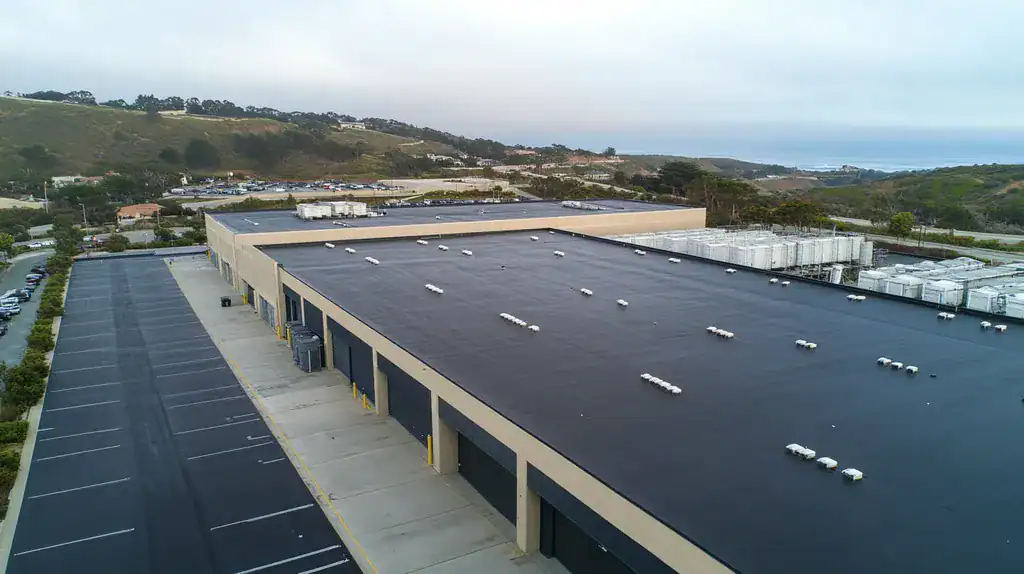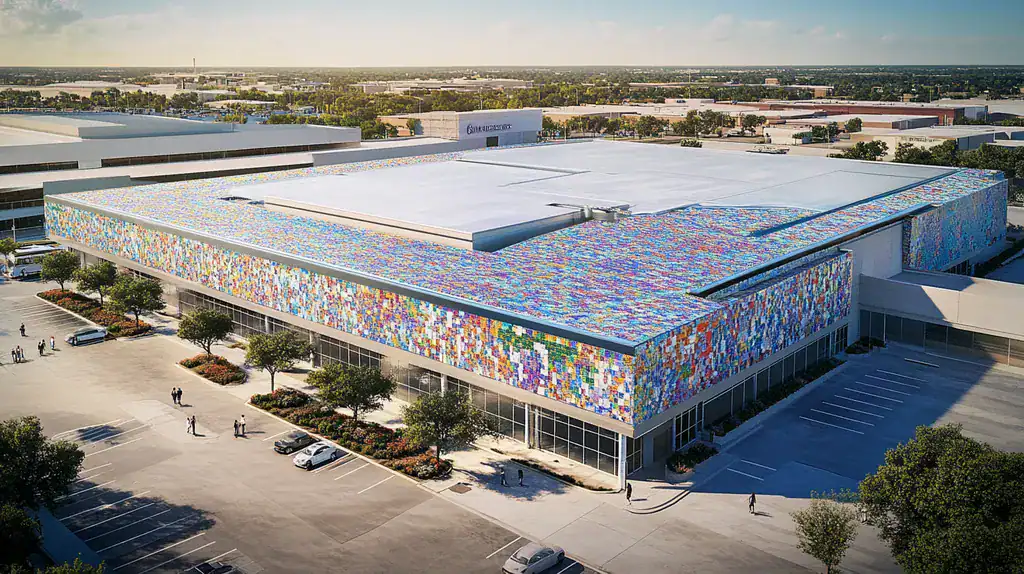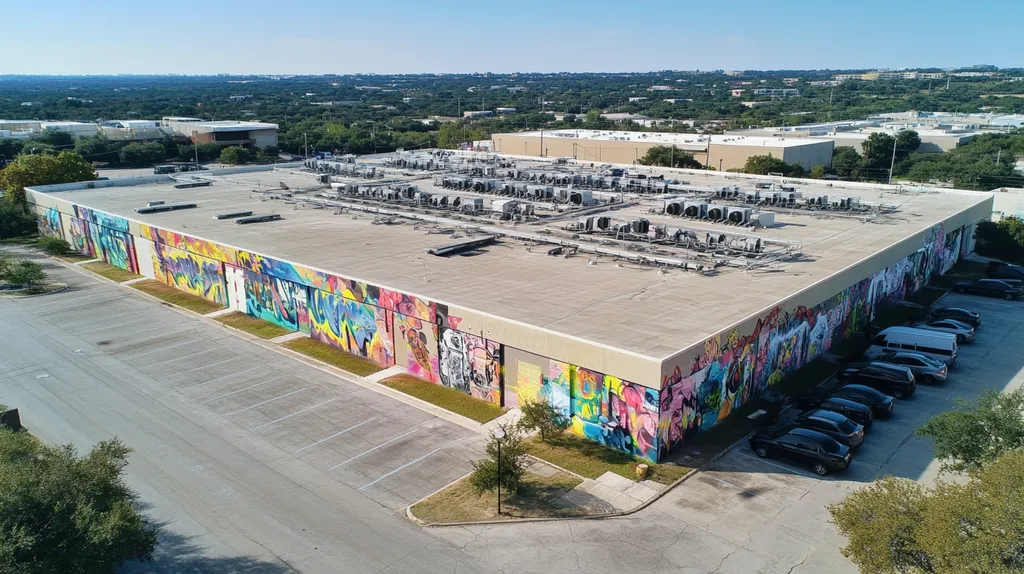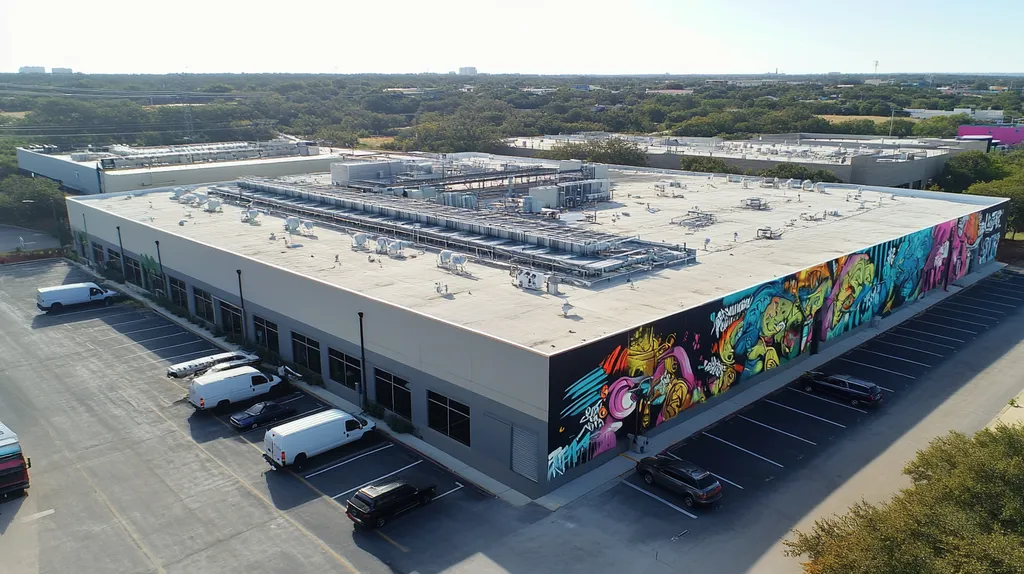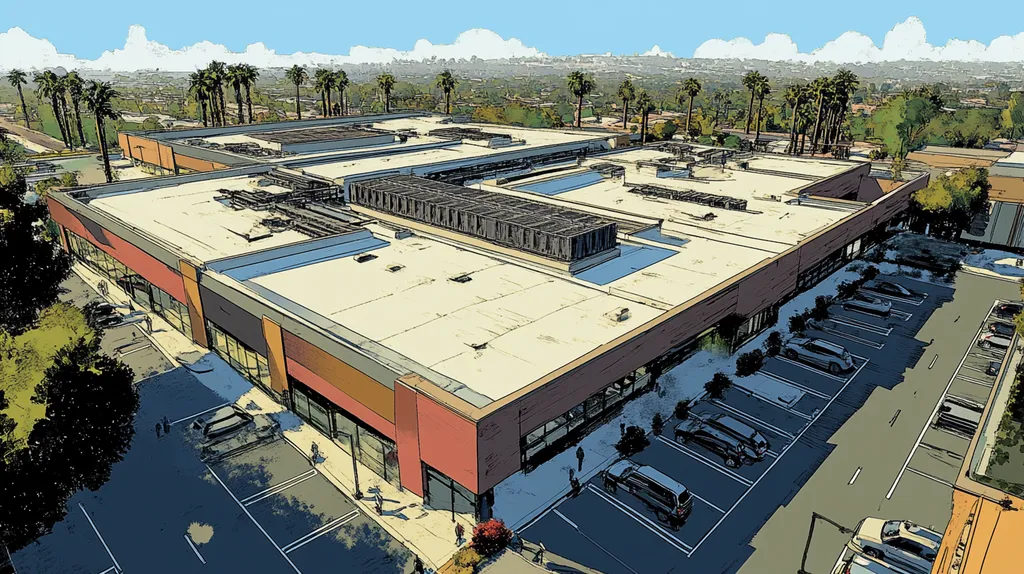Nearly one in five commercial roofs face premature replacement today, with roofing materials ranking among the top four contributors to construction waste in US landfills. This environmental crisis stems largely from outdated recoating practices that ignore modern material innovations and installation methods.
The commercial roofing industry’s adherence to conventional approaches continues despite clear evidence of their limitations. From inadequate surface preparation to mismatched materials, these established practices waste resources while accelerating replacement cycles.
This analysis examines how traditional recoating methods fall short, explores the systemic issues driving failures, and presents data-driven alternatives that promise both sustainability and superior performance.
SECTION 1: CURRENT PRACTICES
In the ever-evolving landscape of commercial roofing, traditional recoating practices are contributing to an alarming trend. Nearly one in five commercial roofs are prematurely replaced, creating significant environmental impact as roofing materials become one of the top four construction materials in US landfills. This wasteful cycle stems from outdated approaches to roof maintenance and recoating that fail to consider modern sustainability demands and advanced material options. (source: Simon Roofing)
Overview of Recoating Methods
Commercial roof recoating has evolved from simple tar applications to sophisticated multi-layer systems. Today’s methods primarily revolve around fluid-applied membranes, including silicone, acrylic, and polyurethane coatings.
Each coating system serves specific purposes, with silicone excelling in UV protection and water resistance, while acrylics offer superior adhesion and flexibility. Polyurethane provides exceptional durability but requires precise application conditions.
Application methods vary from spray systems to roller applications, with each technique affecting coverage, thickness, and ultimate performance. Modern equipment has improved application precision, though many contractors still rely on outdated tools.
Climate considerations increasingly influence method selection, as extreme weather patterns demand more resilient solutions. Yet many facilities continue using conventional approaches ill-suited to changing environmental conditions.
Common Recoating Materials Used
Today’s commercial roof coatings represent a dramatic departure from the coal tar and asphalt systems of previous decades. Modern formulations incorporate advanced polymers and reflective pigments that enhance both durability and energy efficiency.
Silicone coatings dominate the market due to their exceptional weathering characteristics and simple recoat requirements. These materials maintain flexibility and performance even after decades of UV exposure.
Acrylic coatings offer cost-effective solutions for moderate climates, though they may require more frequent maintenance. Their water-based formulation makes them environmentally friendly but potentially less durable in extreme conditions.
Emerging hybrid materials combine the benefits of multiple coating types, though adoption remains limited by contractor familiarity and higher initial costs. These innovative solutions often outperform traditional materials in longevity tests.
Industry Standards for Application
Current application standards emphasize surface preparation and environmental conditions during installation. However, these guidelines often lag behind material innovations and changing climate patterns.
Temperature and humidity requirements remain critical factors, with most coatings demanding specific ranges for proper curing. Modern monitoring equipment helps ensure compliance, though many contractors rely on outdated assessment methods.
Quality control procedures have evolved to include digital documentation and testing protocols. Despite these advances, inspection practices often focus on immediate results rather than long-term performance indicators.
Training requirements vary widely across regions and materials, creating inconsistent application quality. This variation leads to premature failures and contributes to the industry’s substantial waste footprint.
SECTION 2: SYSTEMIC ISSUES
The evolution of commercial roof recoating from simple tar applications to advanced polymer systems has brought both progress and persistent challenges. Today’s systemic issues stem from decades of established practices that fail to adapt to modern materials and methods. These problems manifest in three critical areas: inadequate surface preparation, material incompatibility, and warranty coverage gaps.
Inadequate Surface Preparation
The foundation of any successful roof recoating project lies in thorough surface preparation, yet this critical step often receives minimal attention. Many commercial roofs are prematurely replaced due to preparation failures that compromise coating adhesion and performance.
Modern coating systems demand meticulous cleaning protocols that many contractors bypass in favor of faster turnaround times. This rush to completion often results in trapped moisture, debris, and contamination beneath new coatings.
Testing procedures for surface readiness have evolved significantly, but adoption remains inconsistent across the industry. Many contractors still rely on visual inspection alone, missing crucial moisture content and adhesion indicators.
When surface preparation falls short, the resulting coating failures create substantial waste in landfills as roofing materials become one of the top four construction materials disposed of in the US. (source: Simon Roofing)
Lack of Material Compatibility
Material compatibility issues plague the recoating industry as new coating technologies encounter aging roof substrates. The challenge intensifies when multiple coating layers accumulate over decades of maintenance.
Chemical interactions between incompatible materials can trigger immediate adhesion failures or gradual degradation. These reactions often remain undetected until significant damage occurs.
The industry’s push toward sustainable solutions has introduced new coating formulations that may conflict with existing roofing systems. Without proper compatibility testing, these eco-friendly alternatives can ironically lead to premature roof replacement.
Documentation of existing roof compositions often proves inadequate for proper coating selection. This knowledge gap leads to speculative decisions about material compatibility.
Insufficient Warranty Coverage
Warranty terms for recoating projects frequently contain exclusions that leave property owners exposed to significant financial risk. These limitations often become apparent only after coating failures occur.
Environmental factors like extreme weather events increasingly impact coating performance, yet many warranties exclude these conditions. This coverage gap grows more problematic as climate patterns become less predictable.
Standard warranties typically focus on material defects while overlooking installation quality. This division of responsibility creates confusion when determining the root cause of coating failures.
The industry’s reliance on prorated coverage further diminishes warranty value over time. Property owners often discover that their protection decreases precisely when aging coatings become most vulnerable to failure.
SECTION 3: MISSED OPPORTUNITIES
The commercial roofing industry stands at a critical crossroads where outdated recoating practices collide with modern innovation potential. While building technology has evolved dramatically, many facilities cling to conventional approaches that waste both energy and financial resources. This resistance to change means many buildings miss significant opportunities for improved performance, sustainability, and cost reduction.
Energy Efficiency and Savings
Modern coating technologies offer unprecedented potential for energy conservation, yet many facilities continue using traditional dark-colored or minimally reflective materials. These outdated choices create unnecessary heat absorption, forcing cooling systems to work harder and consume more energy.
Today’s high-performance reflective coatings can reduce roof surface temperatures by up to 50-60 degrees Fahrenheit compared to traditional black roofing. This temperature reduction directly translates to lower cooling costs and reduced strain on HVAC equipment.
Roofing materials account for nearly 20% of landfill construction waste, with many roofs being replaced prematurely due to poor energy performance and heat-related degradation. This cycle of waste continues as facilities overlook energy-efficient coating options that could extend roof life while reducing operating costs. (source: Simon Roofing)
Smart coating choices can also qualify buildings for energy incentives and green building certifications, creating additional value streams that many property owners leave untapped.
Enhanced Durability through Upgrades
The latest coating technologies offer dramatically improved weathering characteristics compared to products from just a decade ago. These advanced materials provide superior resistance to UV degradation, thermal cycling, and moisture penetration.
Modern elastomeric coatings maintain their protective properties even after years of exposure to extreme weather conditions. Their ability to expand and contract with the building prevents the cracking and separation common with older coating systems.
Integration of new nanomaterials and hybrid polymers creates coating systems that self-heal minor damage and resist biological growth. These innovations extend maintenance intervals and reduce the frequency of major repairs.
Despite these advantages, many facilities continue applying outdated coatings that require more frequent maintenance and offer shorter service lives.
Potential for Cost Reduction
The financial benefits of modern coating systems extend far beyond simple energy savings. Advanced materials typically offer longer warranty periods and reduced maintenance requirements, creating substantial lifecycle cost advantages.
Innovative coating systems can defer roof replacement by 10-15 years when properly installed and maintained. This extended service life represents significant capital expense savings that many property owners fail to consider.
Modern coatings often integrate seamlessly with building automation and monitoring systems. This integration enables predictive maintenance strategies that prevent costly emergency repairs.
The combination of energy savings, extended service life, and reduced maintenance creates compelling financial returns that many facilities miss by focusing solely on initial application costs.
SECTION 4: ROOT CAUSES
The commercial roofing industry faces a crisis of premature failures that stem from deeply entrenched practices. Each year, thousands of roofs require early replacement due to fundamental oversights in installation, maintenance, and material selection. These preventable issues create a cycle of waste that burdens both property owners and the environment, with roofing materials becoming one of the top four construction materials in US landfills. (source: Simon Roofing)
Poor Installation Techniques
Modern coating systems demand precision application methods that many contractors have yet to master. Surface preparation shortcuts, improper material mixing, and rushed curing times create weak points that lead to premature coating breakdown.
Environmental conditions during installation play a crucial role in coating performance. Temperature, humidity, and dew point measurements require constant monitoring, yet many crews rely on outdated assessment methods.
Equipment calibration and maintenance directly impact coating thickness and consistency. Modern spray systems require regular adjustment and cleaning to maintain optimal performance, but these procedures often get overlooked in the rush to complete projects.
Quality control documentation frequently lacks the detail needed to validate proper installation. Without comprehensive records of environmental conditions and application parameters, troubleshooting becomes speculative rather than systematic.
Lack of Maintenance and Inspections
Regular inspection protocols have evolved significantly, yet many facilities still operate on outdated maintenance schedules. Modern coating systems require different monitoring approaches than their predecessors, but inspection criteria often remain unchanged.
Diagnostic tools have advanced considerably, offering new ways to detect coating problems before visible damage occurs. However, many maintenance teams continue relying solely on visual inspections that miss early warning signs.
Documentation systems for tracking coating performance over time remain inconsistent across the industry. Without standardized monitoring protocols, facility managers struggle to make informed decisions about maintenance timing.
Weather pattern changes demand more frequent inspections than traditional quarterly or annual schedules provide. Yet budget constraints often force maintenance teams to extend intervals between thorough roof examinations.
Inadequate Material Selection
Material selection criteria often prioritize initial cost over lifetime performance. This short-term thinking leads to choosing coating systems ill-suited for specific building conditions and climate challenges.
Chemical compatibility between new coatings and existing roof surfaces requires careful analysis. Many specification processes skip crucial testing steps, leading to adhesion failures and premature coating breakdown.
Regional climate variations demand specialized coating formulations, yet many projects default to standard systems. This one-size-fits-all approach ignores critical factors like UV exposure, rainfall patterns, and temperature extremes.
Emerging coating technologies offer improved performance but face resistance due to higher initial costs. This hesitation to adopt advanced materials perpetuates the cycle of frequent recoating and premature roof replacement.
DATA DRIVEN EVIDENCE
The commercial roofing industry faces a sustainability crisis driven by premature replacements and ineffective recoating practices. Nearly 20% of commercial roofs are replaced before reaching their full lifespan, with roofing materials becoming one of the top four construction materials in US landfills. This wasteful pattern stems from outdated approaches that ignore modern material innovations and installation methods. (source: Simon Roofing)
Historical Data on Recoating Failures
Analysis of commercial roof failures reveals that over 40% of recoating projects show signs of degradation within their first five years. This premature aging typically stems from inadequate surface preparation and poor material selection.
Documentation from major metropolitan areas indicates that traditional recoating methods result in an average service life reduction of 30-40% compared to manufacturer specifications. These shortened lifecycles create unnecessary waste and accelerate replacement cycles.
Temperature fluctuations and extreme weather events contribute significantly to coating failures. Records show that roofs in regions experiencing dramatic temperature swings suffer coating failures at twice the rate of those in moderate climates.
Project data from the past decade demonstrates that buildings using outdated recoating specifications experience 60% more emergency repairs than those employing modern coating systems and application methods.
Comparative Analysis of Alternatives
Modern elastomeric coatings demonstrate superior performance metrics compared to traditional materials. Field testing shows these advanced formulations maintain their protective properties three times longer than conventional coatings.
Cool roof technologies incorporating reflective pigments and UV-resistant polymers reduce surface temperatures by up to 50 degrees Fahrenheit. This temperature reduction translates to measurable decreases in cooling costs and extended coating lifespans.
Hybrid coating systems combining multiple protective technologies show particular promise. These innovative solutions demonstrate 40% better weathering characteristics and significantly reduced maintenance requirements.
Smart coating materials with self-healing capabilities and enhanced moisture resistance are proving especially effective. Early adoption data indicates these systems can extend recoating intervals by 5-7 years.
Statistical Insights on Cost Effectiveness
Financial analysis reveals that buildings employing modern recoating systems reduce their annual maintenance costs by an average of 35%. This savings compounds over time as fewer emergency repairs become necessary.
Energy efficiency improvements from advanced coating systems generate measurable returns. Buildings using modern reflective coatings report cooling cost reductions ranging from 20-30% during peak summer months.
Long-term cost tracking demonstrates that proper initial investment in quality materials and application yields a positive return within 3-5 years. This return accelerates in regions with high cooling demands or extreme weather patterns.
Maintenance records show that buildings following updated recoating specifications require 45% fewer emergency repairs. This reduction in unplanned expenses provides significant budget stability for facility managers.
SECTION 6: ALTERNATIVE SOLUTIONS
As traditional roofing practices fill landfills with prematurely replaced materials, the commercial roofing industry stands at a critical turning point. Many roofs are replaced before reaching their intended lifespan, making roofing materials one of the top four construction materials in US landfills. This wasteful cycle demands a fundamental shift in how we approach roof recoating and maintenance. (source: Simon Roofing)
Advanced Materials and Technologies
Modern coating systems represent a dramatic evolution from traditional materials, offering unprecedented durability and performance. Smart coatings incorporating self-healing polymers and nano-materials can actively respond to environmental stresses, extending service life beyond conventional expectations.
Hybrid coating systems combine multiple protective technologies into single applications, delivering superior resistance to UV radiation, thermal cycling, and moisture penetration. These advanced formulations maintain their protective properties even after decades of exposure.
Diagnostic integration allows modern coatings to work with building automation systems for real-time performance monitoring. Embedded sensors can detect moisture intrusion and coating degradation before visible damage occurs.
The latest coating chemistries incorporate phase-change materials that actively regulate roof surface temperatures. This temperature control extends coating life while reducing building cooling demands.
Sustainable and Eco-Friendly Options
Bio-based coating systems derived from renewable resources now match or exceed the performance of traditional petroleum-based products. These materials reduce environmental impact while delivering superior weathering characteristics.
Reflective coating technologies have advanced beyond simple white surfaces to include specialized pigments that reflect infrared radiation. This enhanced reflection capability dramatically reduces heat absorption while maintaining desired aesthetic appearances.
Green roof integration systems allow vegetation to coexist with protective coatings, creating multi-functional roofing solutions. These hybrid approaches combine durability with improved stormwater management and urban heat island reduction.
Recycled content coatings incorporate post-consumer materials without compromising performance. Advanced processing methods ensure these sustainable options maintain consistent quality and application characteristics.
Innovative Application Techniques
Robotic application systems ensure consistent coating thickness and coverage while reducing labor requirements and human error. These automated solutions deliver precision that exceeds manual application capabilities.
Advanced surface preparation technologies use combination methods including vacuum abrasion and controlled pressure washing. These techniques create optimal substrate conditions for coating adhesion while minimizing waste and environmental impact.
Spray systems with real-time monitoring adjust application parameters based on environmental conditions. This dynamic response ensures proper coating cure regardless of temperature or humidity variations.
Non-destructive testing methods using thermal imaging and electrical impedance measurements verify coating integrity immediately after application. This immediate feedback allows corrections before problems become embedded in the finished system.
Moving Forward
With roofing materials representing one of the top four construction materials in US landfills, the commercial roofing industry can no longer afford to cling to outdated recoating practices.
The data clearly shows that traditional methods result in premature failures, wasted resources, and unnecessary environmental impact.
Modern coating technologies, from self-healing polymers to bio-based formulations, offer proven solutions that extend roof life while reducing energy costs and maintenance demands.
The industry stands at a critical crossroads: continue with established practices that fill landfills and drain budgets, or embrace innovative solutions that deliver both sustainability and superior performance.
The choice between these paths will define commercial roofing’s environmental and economic impact for decades to come.
FREQUENTLY ASKED QUESTIONS
Q. What are the current practices for recoating a commercial roof?
A. Modern recoating practices have shifted from basic tar applications to advanced fluid-applied membranes. These systems include silicone, acrylic, and polyurethane coatings, each serving specific needs like UV protection and durability. Proper application methods, such as spray or roller techniques, play a crucial role in ensuring effective performance and longevity.
Q. What systemic issues affect industrial roof recoating practices?
A. Systemic issues in recoating stem from inadequate surface preparation, material incompatibility, and insufficient warranty coverage. Many contractors skip necessary cleaning protocols and compatibility tests, leading to early failures and increased costs. Additionally, warranty agreements often lack critical coverage for environmental factors, leaving property owners at financial risk.
Q. What missed opportunities exist in commercial roof maintenance?
A. Many industrial roofs miss significant energy efficiency and cost reduction opportunities by using outdated materials. New reflective coatings can lower temperatures, reducing cooling costs significantly. Additionally, modern technologies provide greater durability and less frequent maintenance, yet many facilities continue to rely on older, less efficient systems.
Q. What are the root causes of premature failures in commercial roofs?
A. Premature failures are often caused by poor installation techniques, lack of maintenance, and inadequate material selection. Contractors frequently overlook detailed surface preparation and environmental conditions during application, leading to weak points. Additionally, many facilities delay necessary inspections, allowing minor issues to escalate into significant problems.
Q. What data supports the need for modern recoating practices?
A. Historical data indicates that 20% of commercial roofs are replaced prematurely, significantly contributing to landfill waste. Studies show over 40% of recoating projects show degradation within five years due to inadequate processes. This underscoring waste and inefficiency highlights the urgent need for adopting modern methodologies and materials.
Q. What alternative solutions are available for roof recoating?
A. Alternatives include advanced materials like self-healing polymers and hybrid systems that combine several technologies. These options extend roof lifespan and enhance performance. Additionally, eco-friendly coatings and innovative application techniques, such as robotic assistance and non-destructive testing, can significantly improve results and reduce waste.
Q. How do environmental factors impact commercial roof coatings?
A. Environmental conditions like temperature, humidity, and seasonal fluctuations critically affect coating performance. Certain materials may not bond properly if applied under suboptimal conditions, leading to premature failures. Increased awareness of these factors is crucial for improving roof maintenance and extending service life, ensuring materials perform as intended.


